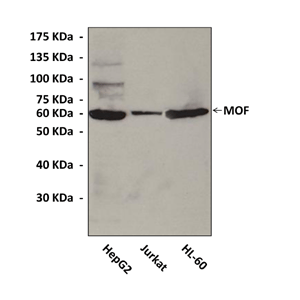Product Sheet CC10023
Description
BACKGROUND MOF, known as hMOF/MYST1/KAT8 in humans, is an acetyltransferase conserved among higher eukaryotes, which specifically acetylates histone H4 at lysine 16 (H4K16ac). A single histone H4K16ac modification modulates both higher-order chromatin structure and functional interactions between a nonhistone protein and the chromatin fiber. MOF is one of the MYST (MOZ, YBF2, SAS2, and Tip60) histone acetyltransferase (HAT) family. It was originally described as an essential component of the X chromosome dosage compensation male-specific lethal (MSL) complex in Drosophila, causing a 2-fold increase in the expression of X-linked genes in male flies. The function of MOF in dosage compensation is mediated by its acetyltransferase activity, which is tightly regulated by the MSL proteins. In vitro biochemical studies revealed that MOF protein alone does not acetylate nucleosomal H4. Instead, the specific and efficient acetylation by MOF depends on its interaction with the coiled-coil domain containing protein MSL1 and the chromo-domain containing protein MSL3. Both components are highly conserved among eukaryotes. It has been shown that MSL1 functions to increase the HAT activity of MOF and to bridge the interaction between MOF and MSL3. MSL3 plays an important role in increasing the substrate specificity of MOF, directing its activity to nucleosomal H4. Other components (i.e., MSL2, MLE, and RNA components roX1 and roX2) are required to specifically recruit MOF to a distinct collection of chromatin entry sites on the Drosophila male X chromosome.1 However, it was also demonstrated that MOF is not only involved in the onset of dosage compensation, but also acts as a regulator of gene expression in the Drosophila genome. MOF displays differential binding behavior depending on whether the target gene is located on the X chromosome versus the autosomes.2 Compared to studies in Drosophila dosage compensation, the functions of MOF in mammals are less well characterized. In mammals, MOF is ubiquitously expressed and is clearly targeted to all chromosomes. Loss of MOF gene in mice causes peri-implantation lethality, as a result of massive disruptions of chromatin architecture in a wide range of cells. In addition, to maintain normal chromatin structure, MOF is important for ATM-dependent cell-cycle checkpoint control as well as in transcription activation of Hox genes in coordination with the H3 K4 methyltransferase MLL. It was shown that MOF, through H4K16ac (histone code), has a critical role at multiple stages in the cellular DNA damage response and DSB repair.3 MOF was also reported to acetylate nonhistone substrate p53 at K120, which occurs rapidly after DNA damage and promotes gene-specific responses.
Several studies suggest that MOF exists in multiple complexes in mammalian cells. In addition to the MSL complex, which is the highly conserved counterpart to the Drosophila MSL complex, MOF was reported to interact with several proteins, including WDR5, a key component of the MLL family H3 K4 methyltransferase complexes. It was further demonstrated that MOF forms a stable complex with MLL and supports p53-dependent transcription activation in vitro. In addition to MOF-MSL complex, another MOF complex, MOF-MSL1v1, was reported. It was demonstrated that the activity of the MOF-MSL1v1 complex is significantly different from that of the MSL complex. While the two MOF complexes have indistinguishable activity on histone H4 K16, they differ dramatically in acetylating nonhistone substrates. We demonstrate that the MOF-MSL1v1 complex is exclusively required for acetylating transcription factor p53 and for the optimal transcription activation of p53 target genes both in vitro and in vivo. Functional distinction of these two MOF complexes is further supported by their different binding patterns along the transcribed genes as well as their functional and/or physical interactions with different histone methyltransferases.4
Several studies suggest that MOF exists in multiple complexes in mammalian cells. In addition to the MSL complex, which is the highly conserved counterpart to the Drosophila MSL complex, MOF was reported to interact with several proteins, including WDR5, a key component of the MLL family H3 K4 methyltransferase complexes. It was further demonstrated that MOF forms a stable complex with MLL and supports p53-dependent transcription activation in vitro. In addition to MOF-MSL complex, another MOF complex, MOF-MSL1v1, was reported. It was demonstrated that the activity of the MOF-MSL1v1 complex is significantly different from that of the MSL complex. While the two MOF complexes have indistinguishable activity on histone H4 K16, they differ dramatically in acetylating nonhistone substrates. We demonstrate that the MOF-MSL1v1 complex is exclusively required for acetylating transcription factor p53 and for the optimal transcription activation of p53 target genes both in vitro and in vivo. Functional distinction of these two MOF complexes is further supported by their different binding patterns along the transcribed genes as well as their functional and/or physical interactions with different histone methyltransferases.4
REFERENCES
1. Mellert, H.S. & McMahon, S.B.: Mol. Cell 36:174-5, 2009
2. Kind, J. et al: Cell 133:813-28, 2008
3. Sharma, G.G. et al: Mol. Cell. Biol. 30:3582-95, 2010
4. Li, X. et al: Mol. Cell 36:290-301, 2009
2. Kind, J. et al: Cell 133:813-28, 2008
3. Sharma, G.G. et al: Mol. Cell. Biol. 30:3582-95, 2010
4. Li, X. et al: Mol. Cell 36:290-301, 2009
Products are for research use only. They are not intended for human, animal, or diagnostic applications.
Details
Cat.No.: | CC10023 |
Antigen: | Raised against recombinant human MOF fragments expressed in E. coli. |
Isotype: | Mouse IgG1 |
Species & predicted species cross- reactivity ( ): | Human, Mouse |
Applications & Suggested starting dilutions:* | WB 1:1000 IP 1:50 IHC 1:100 ICC n/d FACS n/d |
Predicted Molecular Weight of protein: | 60 kDa |
Specificity/Sensitivity: | Detects endogenous MOF proteins in various cell lysate. |
Storage: | Store at -20°C, 4°C for frequent use. Avoid repeated freeze-thaw cycles. |
*Optimal working dilutions must be determined by end user.
Products
| Product | Size | CAT.# | Price | Quantity |
|---|---|---|---|---|
| MOF Mouse Monoclonal Antibody: MOF Mouse Monoclonal Antibody | Size: 100 ul | CAT.#: CC10023 | Price: $302.00 |

